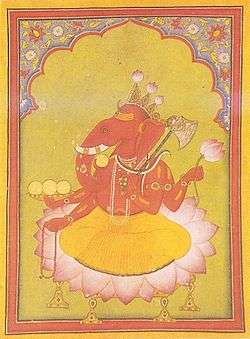Ganapatya
Ganapatya is a denomination of Hinduism that worships Ganesha (also called Ganapati) as the Saguna Brahman.[1]

The worship of Ganesha is considered complementary with the worship of other deities. Hindus of all sects begin prayers, important undertakings, and religious ceremonies with an invocation of Ganesha. The "worship of the five forms" (pañcāyatana pūjā) system, which was popularized by Śaṅkarācārya, invokes the five deities Ganesha, Vishnu, Shiva, Devī, and Sūrya.[3] It is one of the five principal Hindu sects, with Shaivism, Shaktism, Vaishnavism, and Smartism which follows Advaita philosophy. While it is not as large a sect as the first four, it has been influential.
Ganapati has been worshipped as part of Shaivism since at least the fifth century. A specific Ganapatya sect probably began to appear between the sixth and ninth centuries: six sects are mentioned in the Sankara digvijaya (life of Adi Shankara) by Sri Anandigiri. It reached a high point about the tenth century, and built temples dedicated to Ganesha, the largest of which is the Ucchi Pillayar Koil (the Columns Hall of a Thousand Pillars), on the Rock Fort of Tiruchirapalli in Tamil Nadu.Ganesha is worshipped as the Supreme Brahma (Parabrahma) in this sect.Being the chief deity in hinduism,he is known as Parameshwara(Supreme God).
Later, the sect was popularized by Sri Morya Gosavi. According to one source, he found an idol of Ganapati not made by human hands, and built the Morgaon temple near Pune in the 14th century. According to another, he experienced visions of Ganapati at the Morgaon shrine, and was entombed alive (jeeva samadhi) in 1651, in a Ganesha temple at his birthplace in Cinchwad.[4]
Following him, the Ganapatya sect became prominent between the seventeenth and nineteenth centuries in Maharashtra in western India, centering on Cinchwad. Its center is still among high-caste Hindus in the Marathi-speaking region of Maharashtra, and it is important in South India. Devotees hold an annual pilgrimage between Cinchwad and Moragaon.
Sect marks include a red circle on the forehead, or the brands of an elephant face and tusk on the shoulders.
References
- ↑ Ganapatyas Article from PHILTAR, Division of Religion and Philosophy, St Martin's College
- ↑ "Ganesha". The Walters Art Museum.
- ↑ Grimes, John A. Ganapati: Song of the Self. (State University of New York Press: Albany, 1995) p. 162.
- ↑ GĀṆapatyas Article from BookRags.com
External links
- GĀṆapatyas Article from BookRags.com
- Ganapatya Encyclopædia Britannica article

